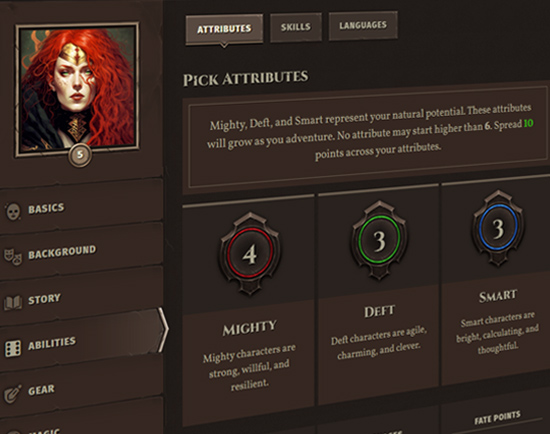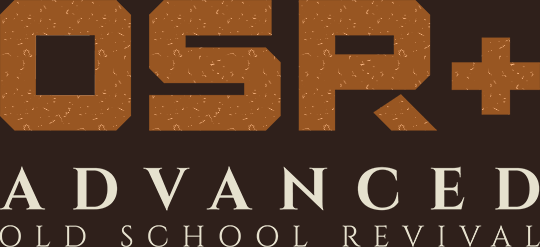The journey action is one you can invoke to simulate, in abstract time, the PCs’ travel over immense distances that may encapsulate many adventures not worth playing out in real time. Think of the journey action as a way to convey the sense of scale that Lord of the Rings conveys when Tolkien describes the characters traveling great distances in the novel.
The Gist of Journeying
In the journey action, the players create points of interest they encounter based on random prompts you suggest (called aspects) that match the theme of the fictional space through which they are journeying. You then have each player roll a single-act scene check to surface perils that hindered them at the point of interest, or narrative advantages they discovered by overcoming it that will help them later on in the adventure.
Prompting the Journey
Determining Hold
When you or the players propose to journey, you decide how long the journey will take by establishing how much hold it takes to complete the journey. Typically you set this number to the number of players involved, so that each player can contribute a point of interest along the way. A clean success or higher on a scene check completes a leg of the journey, yielding 1 hold.
Random Prompts
When it comes to setting the stage for the journey, you start by considering the journey’s theme. For example, in A Quest of Queens, a high fantasy campaign that features epic characters, we had a sidequest called "Tarthquest" that introduced several reluctant Tarth heroes whose journey entailed traveling to the center of the Great Labyrinth, a mystical place that holds high importance in Tarth culture. The Labyrinth was designed to test their honor and courage, so the theme of the journey revolved around what it means to be honorable.
You should decide on the theme when the journey is first discussed in collaboration with the players. You then create two tables of six random options, one table representing a thematic aspect of the journey, and another table representing potential physical points of interest. Each player who creates a point of interest rolls twice on this table: once to get a thematic aspect, and a second time a physical aspect.
Example Aspect Table
| Roll | Thematic aspects | Physical Aspects |
|---|---|---|
| 1 | Loyalty | Dark Tower |
| 2 | Duty | Endless Pit |
| 3 | Respect | Ancient Statue |
| 4 | Selflessness | Withering Tree |
| 5 | Courage | Starlit Lake |
| 6 | Honor | Volcanic Plain |
The player then describes the point of interest and you use its description to come up with the peril it poses to the party. To create an extended scene, you can have each player describe something they see during the journey to the point of interest, inspired by the thematic aspect the player rolled, as a downtime.
Resolving the Journey
A point of interest always poses a peril that the PCs must overcome to pass through. If the player isn't sure of the peril it poses, you get to decide what it is. In either case, you must choose which attribute is best to resist it, and then the party rolls a single-act scene check against it. In Tarthquest, the players came up with the following perils based on the example tables:
- Duty & Starlit Lake. A mysterious hut on the side of a beach, with an extra-dimensional interior. Passersby took refuge inside the hut, but the hut was enchanted with evil magic that enticed visitors to stay forever, showing them illusions of a place they deemed most safe and relaxing. The attribute in this case was Smart in order to see through the illusion.
- Selflessness & Volcanic Plain. A vast volcanic waste stretched out for miles, boiling over with lava flows and intense heat. The volcanic plain had the magical property of making passersby turn against each other, egged on by the plumes of hatred magically infesting the place. In this case, Deft was the attribute to check against, because overcoming hatred requires empathy.
- Respect & an Ancient Statue. A giant, abandoned statue in a glacial plain, built to venerate Tarth culture. The only way to pass through the plain was to pass under the statue, which stands upon a treacherous landscape that sheds deadly sheets of ice when anyone passes through. Deft again was appropriate for this peril, as it requires quick reflexes to avoid.
Complications & Rewards
While you can use the outcomes suggested by the single-act scene check (which consist of GM or player advantage), below are some examples of journey-specific outcomes that result in tangible rewards. It's helpful to bind the outcomes to the aspects you created, that way if a player received "Duty" then the complication would be "Dereliction" (see below). Otherwise, the player can roll randomly. The table below is an example to help you construct your own for your particular journey.
| ROLL | Aspect | Complications | Aspect | Rewards |
|---|---|---|---|---|
| 1 | Treachery | Everyone takes 2 points of attribute damage | Loyalty | The party receives a consumable with the effects of the spell Vivify, or a potion that recovers 1d6 MP. |
| 2 | Greed | Everyone loses all supplies. | Duty | The party discovers consumable materials that can repair 1d6 AP. |
| 3 | Contempt | Everyone receives an ongoing -2 to spell checks. | Courage | The party receives a consumable with the effects of the spell Courage, or a potion that recovers 1d6 HP. |
| 4 | Dereliction | Everyone receives an ongoing -2 to initiative. | Respect | The party discovers a magical consumable, either a potion or scroll. |
| 5 | Disgrace | The player who leads the action receives a tag Maimed for the rest of the journey; roll a body die to determine the limb. The GM may invoke this tag as a -2 once per session against the player on any roll. | Selflessness | The party discovers a consumable, cheap, and luxury. |
| 6 | Cowardice | The player who leads the action receives a Fear tag for the rest of the journey, which the GM may invoke this tag as a -2 once per session against the player on any roll. | Honor | The party discovers a random treasure. |
 Armor
Armor Classes
Classes Conflicts
Conflicts Ethos
Ethos Flaws
Flaws Glossary
Glossary Kits
Kits Maleficence
Maleficence Origins
Origins Shields
Shields Skills
Skills Spells
Spells Stances
Stances Status Effects
Status Effects Tactics
Tactics Talents
Talents Techniques
Techniques Treasure
Treasure Weapons
Weapons











 Hall of Heroes
Hall of Heroes Hall of Legends
Hall of Legends Dungeons & Flagons
Dungeons & Flagons